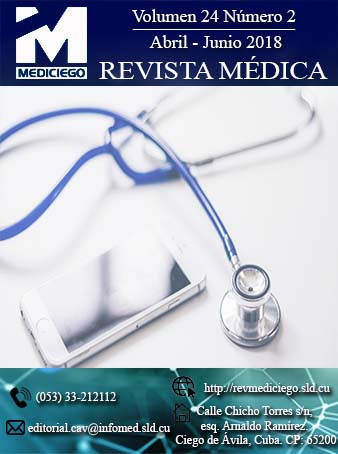Arnold Chiari´s malformation type II
Abstract
Introduction: the Chiari II malformation is the most common within the four types of classification and is the most clinically important due to its frequent association with meningomyelocele.
Objective: to present a case whose symptomatology was compatible with Arnold Chiari malformation type II, which is useful as reference material for neonatologists and neurosurgeons.
Case presentation: male neonate, born by caesarean section due to maternal cephalopelvic disproportion. The mother, resident in the Plurinational State of Bolivia in an area far from the health center, attended only two prenatal consultations. The gestation time was 39 weeks, the weight of 3 900 g and the Apgar score of 9/9. The increase in the cranial circumference and the presence of a protruding lumbar sac through which the meninges were seen and cerebrospinal fluid came out attracted attention. The area was covered with sterile dressing and physiological saline solution, treatment with second-line antibiotics was started and ultrasound of the transfontanellar skull was carried out.
Conclusions: before a neonate with lumbar defect and cephalic circumference greater than 90th percentile, the specialist must take into account the possible existence of malformations of the central nervous system (specifically the neural tube) and hydrocephalus as manifestations of the Arnold Chiari type II syndrome. To confirm the diagnosis, it is useful, because of its innocuousness and immediacy, the transfontanellar skull ultrasound, and the neonate must be evaluated by the specialist in neurosurgery to define the treatmentDownloads
Published
How to Cite
Issue
Section
License
Those authors who have publications with this journal accept the following terms of the License CC Attribution-NonCommercial 4.0 International (CC BY-NC 4.0):
You are free to:
- Share — copy and redistribute the material in any medium or format
- Adapt — remix, transform, and build upon the material
- The licensor cannot revoke these freedoms as long as you follow the license terms.
Under the following terms:
- Attribution — You must give appropriate credit , provide a link to the license, and indicate if changes were made . You may do so in any reasonable manner, but not in any way that suggests the licensor endorses you or your use.
- NonCommercial — You may not use the material for commercial purposes .
- No additional restrictions — You may not apply legal terms or technological measures that legally restrict others from doing anything the license permits.
Notices:
You do not have to comply with the license for elements of the material in the public domain or where your use is permitted by an applicable exception or limitation .
No warranties are given. The license may not give you all of the permissions necessary for your intended use. For example, other rights such as publicity, privacy, or moral rights may limit how you use the material.

























